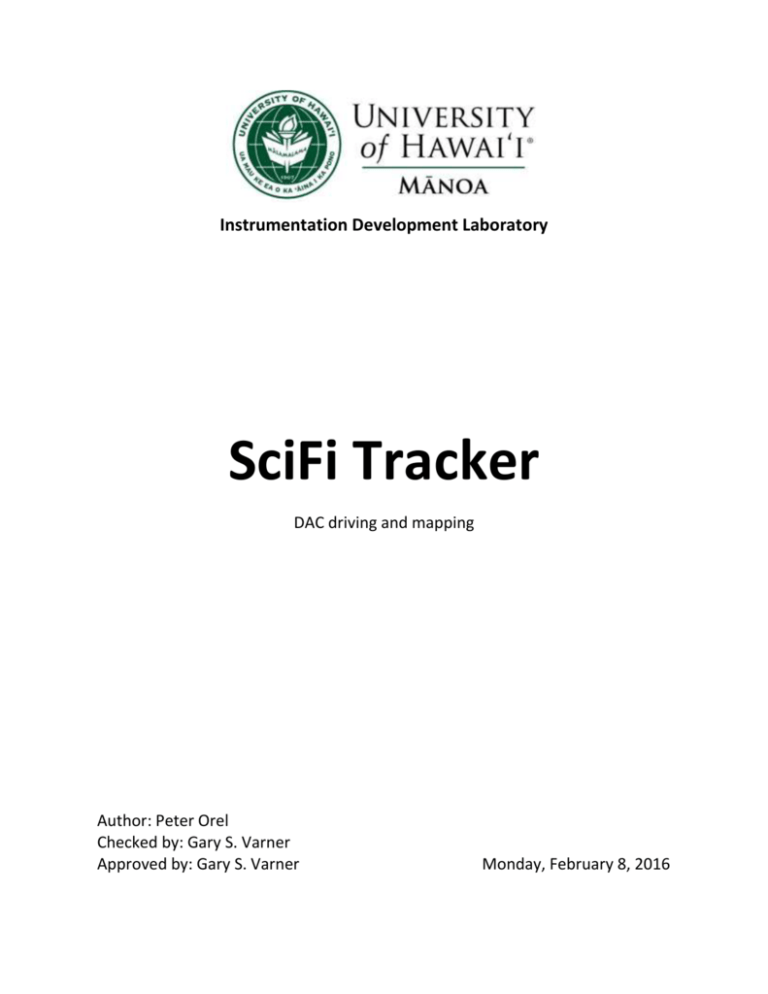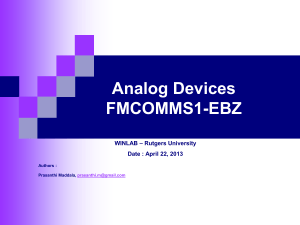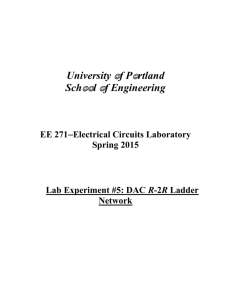doc
advertisement

Instrumentation Development Laboratory SciFi Tracker DAC driving and mapping Author: Peter Orel Checked by: Gary S. Varner Approved by: Gary S. Varner Monday, February 8, 2016 Table of Contents 1 Introduction .......................................................................................................................................... 3 2 Daughter-card DAC (DAC128S085) ....................................................................................................... 4 3 2.1 Driving interface............................................................................................................................ 5 2.2 Initialization and serial input register ........................................................................................... 5 2.3 Output mapping ............................................................................................................................ 7 Power-board DAC (LTC2630-HM12) ..................................................................................................... 8 3.1 Driving Interface............................................................................................................................ 9 3.2 Translating to high-voltage ......................................................................................................... 10 2 1 Introduction In this document we show how the DAC on the daughter cards and power-board are to be operated. 3 2 Daughter-card DAC (DAC128S085) This is a 12bit SPI DAC from Texas Instruments. It has 8 channels with rail-to-rail outputs. Its datasheet can be found on: http://www.ti.com/lit/ds/symlink/dac128s085.pdf The output can swing from 0V to the Vref which in our case is 5V. The transfer characteristics follows the following equation: 𝑉𝑂𝑈𝑇 = 𝐶𝑜𝑢𝑛𝑡𝑠 ∙ 𝑉𝑅𝐸𝐹 𝐶𝑜𝑢𝑛𝑡𝑠 ∙ 5 = [𝑉] 212 4096 5 4.5 4 Voltage [V] 3.5 3 2.5 2 1.5 1 0.5 0 0 500 1000 1500 2000 2500 Counts 3000 3500 4000 4500 Figure 1: DAC Voltage output vs Counts Where the LSB bit is 1.2mV. To get the output voltage the mentioned equation can be reversed: 𝐶𝑜𝑢𝑛𝑡𝑠 = 𝑟𝑜𝑢𝑛𝑑 ( 𝑉𝑂𝑈𝑇 [𝑉] ∙ 212 ) 5[𝑉] Notice the use of the round function. This means that the counts have to be an integer value. 4 2.1 Driving interface The DAC is driven by a serial 3-wire SPI interface which can be clocked up to 40MHz. A write sequence begins by bringing the SYNC line low. Once SYNC is low, the data on the DIN line is clocked into the 16-bit serial input register on the falling edges of SCLK. To avoid mis-clocking data into the shift register, it is critical that the SYNC line is not brought low on a falling edge of the SCLK. On the 16th falling edge of SCLK, the last data bit is clocked into the register. The write sequence is concluded by bringing the SYNC line high. Once SYNC is high, the programmed function (a change in the DAC channel address, mode of operation and/or register contents) is executed. To avoid mis-clocking data into the shift register, it is critical that SYNC be brought high between the 16th and 17th falling edges of SCLK [1]. Figure 2: DAC SPI timing diagram 2.2 Initialization and serial input register The DAC accepts a 16bit word which is divided into two blocks. Bits 15 to 12 are used to control the mode of operation Bits 11 to 0 control the output setting of the voltage or a special function setting if used. The DAC has two modes of operation: WRM (write register mode) DB[15:12]=1000 This is the default wake-up mode, where writing into the register doesn’t affect the outputs. WTM (write through mode) DB[15:12]=1001 This mode is where the output gets updated immediately after the writ sequence 5 For setting the output voltage the input register needs to be written. The first 12 bits DB[11:0] of the 16bit word are used for inputting counts value while. Bits 14 to 12 DB[14:12] are used to select the specific output (1 to 8). Bit 15 must be a logic 0. Figure 3: Input register table The special function will not be required in this application therefore will not be discussed in this document. EXAMPLE: The DAC wakes up at 0V on all outputs (input register filled with 0s) and in the WRM mode. Since we don’t need all of the outputs to be updated at the same time we can immediately set the mode to WRT by sending command: 1001000000000000. After we can begin with writing each output individually by: 0001001011100011. In this example we are writing DAC number 1 with a voltage of 0.9V. 6 2.3 Output mapping In the daughter-card the output map to specific channels. The following table summarizes the channel mapping: DAC CS 1 1 1 1 1 1 1 1 2 2 2 2 2 2 2 2 Output Address 000 001 010 011 100 101 110 111 000 001 010 011 100 101 110 111 Physical channel NOT USED CH11 CH14 CH15 CH13 CH10 CH8 CH7 CH12 CH9 CH6 CH3 CH4 CH1 CH5 CH2 7 3 Power-board DAC (LTC2630-HM12) This is a 12bit, single channel, SPI driven DAC. Its datasheet can be found on: http://cds.linear.com/docs/en/datasheet/2630ff.pdf The output can swing from 0V up to the internal reference, which in our case is 4.096V or alternatively it can be set to use the power supply as reference in which case the full range is 5V. The transfer characteristics follows the following equation: 𝑉𝑂𝑈𝑇 = 𝐶𝑜𝑢𝑛𝑡𝑠 ∙ 𝑉𝑅𝐸𝐹 𝐶𝑜𝑢𝑛𝑡𝑠 ∙ 𝑉𝑅𝐸𝐹 = [𝑉] 212 4096 5 4096mV REF 5000mV REF 4.5 4 Voltage [V] 3.5 3 2.5 2 1.5 1 0.5 0 0 500 1000 1500 2000 2500 Counts 3000 3500 4000 4500 Figure 4: DAC Voltage output vs Counts Where the LSB bit is 1.2mV for 5V reference and 1mV in the case of the internal reference. To get the output voltage the mentioned equation can be reversed: 𝐶𝑜𝑢𝑛𝑡𝑠 = 𝑟𝑜𝑢𝑛𝑑 ( 𝑉𝑂𝑈𝑇 [𝑉] ∙ 212 ) 𝑉𝑅𝐸𝐹 [𝑉] 8 3.1 Driving Interface The SPI interface can be clocked up to 50MHz. The CS/LD input is level triggered. When this input is taken low, it acts as a chip-select signal, enabling the SDI and SCK buffers and the input shift register. Data (SDI input) is transferred at the next 24 rising SCK edges. The 4-bit command, C3-C0, is loaded first; then 4 don’t-care bits; and finally the 16-bit data word. The data word comprises the 12-bit input code, ordered MSB-to-LSB, followed by 4 don’t-care bits. Data can only be transferred to the device when the CS/LD signal is low, beginning on the first rising edge of SCK. SCK may be high or low at the falling edge of CS/LD. The rising edge of CS/LD ends the data transfer and causes the device to execute the command specified in the 24-bit input sequence. This DAC wakes up at mid-range (2.048V or 2.5V) which is necessary for our application. The commands that can be used are shown in the following table: This command are set by using the bits 24 to 21 Bit sequence DB[24:21] 0000 0001 0011 0100 0110 0111 Command description Write to input register Update DAC register and power up Write, update and power up Power Down Select internal reference Select PS as reference (Vref=Vcc) The timing diagram of the sequence is shown in the following figure: Figure 5: DAC timing diagram At startup the DAC is at mid-supply and the internal reference is used. If we want to set the voltage range to 5V we can use the command code 0111. During this operation the other 16bits are ignored. Then to set the output voltage we perform a write sequence: 0011 0000 1011 0011 1001 0000 Where we write and update the output voltage to a value of 2.87V 9 3.2 Translating to high-voltage The DAC drives a high voltage power supply EMCO SIP90. Where the output voltage follows the given equation: 𝑉𝑂𝑈𝑇 = 90.5 − 14.1 ∙ 𝑉𝐷𝐴𝐶 100 5000mV REF 4096mV REF 90 High Voltage Out [V] 80 70 60 50 40 30 20 0 0.5 1 1.5 2 2.5 3 DAC vooltage [V] 3.5 4 4.5 5 Figure 6: High voltage out vs DAC voltage The following equation can be used to simply convert from one voltage/counts to the other: 𝑉𝐷𝐴𝐶 = 90.5 − 𝑉𝐻𝑉 𝐶𝑜𝑢𝑛𝑡𝑠 ∙ 𝑉𝑅𝐸𝐹 = 14.1 212 10








